中国历代服装中英文双语讲解
- 格式:doc
- 大小:971.00 KB
- 文档页数:6
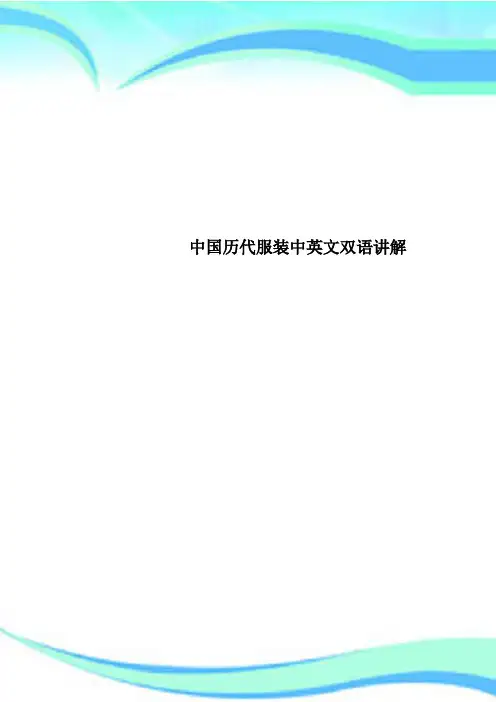
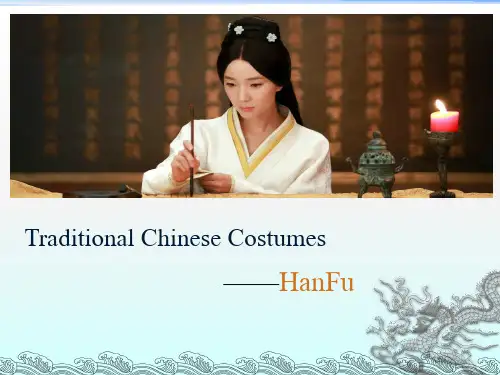
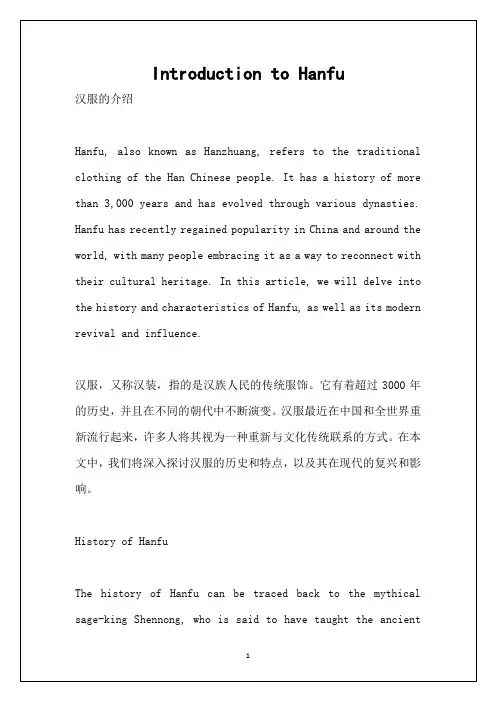
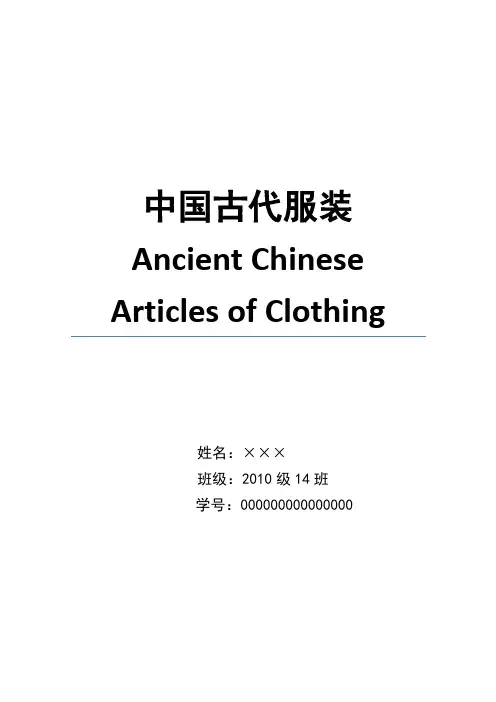
中国古代服装Ancient Chinese Articles of Clothing姓名:×××班级:2010级14班学号:***************中国古代服装中国古代服装包括中国古代的各种衣裳、冠帽、鞋袜等服装,在世界上自成一系,其结构与款式随着生产与生活方式的发展而逐渐变化。
通过对古代服装的研究,可以认识历代人物的风貌。
在鉴定有关文物时,服装也是断代的重要尺度。
古代服装存世不多,在研究中除依据实物外,古代雕塑、绘画中的人物形象,也往往是重要的参考资料。
一、旧石器时代晚期周口店山顶洞人的文化遗存中曾发掘出骨针。
到了新石器时代晚期,在不同地区和族别的人们中间,服饰款式已各不相同。
以发型为例,大地湾文化中有剪短的披发,马家窑文化中有后垂的编发,大汶口文化中有用猪獠牙制成的发箍,龙山文化中则用骨笄(音gǔjī;指兽骨制的簪子)束发,陕西龙山文化之神木石峁(音mǎo)遗址出土的玉人头像,头顶有髻,可能就是用笄束发的反映。
因此得知束发为髻在远古时已是华夏族服装的特征。
二、夏商与西周夏商与西周时的衣着无实物存世。
据安阳侯家庄墓及妇好墓所出玉、石人像,可知商代贵族上身穿交领衣,腰束绅带,下身着裳,腹前系市(蔽膝)。
西周时遗留下来的人像材料更少。
从洛阳出土的玉人及铜制人形车辖来看,衣、裳、带、市仍是贵族男装的基本组成部分。
其衣用正色,裳用间色,并特别重视裳前之市。
三、秦与汉秦始皇陵兵马俑坑中大批陶俑的出土,为秦汉武士的服装提供了较充分的例证。
他们穿的半长衣所交掩之曲裾(音jū;指衣服的大襟或衣服的前后部分)虽较浅,但仍为深衣(古代上衣、下裳相连缀的一种服装。
为古代诸侯、大夫、士家居常穿的衣服,也是庶人的常礼服)之属,其下身着长裤,腰系施钩之革带。
这种装束在西汉时仍广泛流行,裤也逐渐向全社会普及。
冠制的确立是在汉代实现的。
上古时,华夏族之冠主要从属于礼制,男子成年时皆行冠礼。
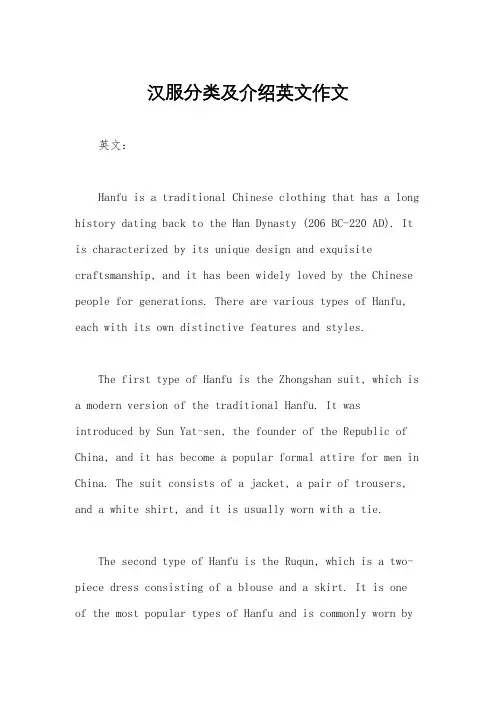
汉服分类及介绍英文作文英文:Hanfu is a traditional Chinese clothing that has a long history dating back to the Han Dynasty (206 BC-220 AD). It is characterized by its unique design and exquisite craftsmanship, and it has been widely loved by the Chinese people for generations. There are various types of Hanfu, each with its own distinctive features and styles.The first type of Hanfu is the Zhongshan suit, which is a modern version of the traditional Hanfu. It was introduced by Sun Yat-sen, the founder of the Republic of China, and it has become a popular formal attire for men in China. The suit consists of a jacket, a pair of trousers, and a white shirt, and it is usually worn with a tie.The second type of Hanfu is the Ruqun, which is a two-piece dress consisting of a blouse and a skirt. It is one of the most popular types of Hanfu and is commonly worn bywomen. The blouse is usually decorated with intricate embroidery and the skirt is long and flowing.The third type of Hanfu is the Beizi, which is a long robe that is worn over a shirt and trousers. It is usually made of silk or cotton and is decorated with patterns and designs. The Beizi was commonly worn by scholars andofficials during the Ming and Qing dynasties.In addition to these three types of Hanfu, there are many other types, such as the Shenyi, the Daxiushan, andthe Banbi. Each type has its own unique features and styles.中文:汉服是一种有着悠久历史的传统中国服饰,起源于汉朝(公元前206年-公元220年)。
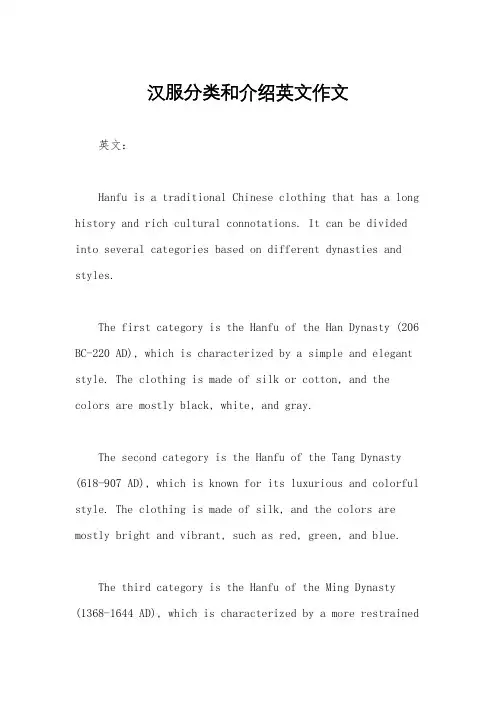
汉服分类和介绍英文作文英文:Hanfu is a traditional Chinese clothing that has a long history and rich cultural connotations. It can be divided into several categories based on different dynasties and styles.The first category is the Hanfu of the Han Dynasty (206 BC-220 AD), which is characterized by a simple and elegant style. The clothing is made of silk or cotton, and the colors are mostly black, white, and gray.The second category is the Hanfu of the Tang Dynasty (618-907 AD), which is known for its luxurious and colorful style. The clothing is made of silk, and the colors are mostly bright and vibrant, such as red, green, and blue.The third category is the Hanfu of the Ming Dynasty (1368-1644 AD), which is characterized by a more restrainedand elegant style. The clothing is made of silk or cotton, and the colors are mostly dark and muted, such as dark blue, black, and brown.In addition to these categories, there are also other styles of Hanfu, such as the Song-style Hanfu, the Yuan-style Hanfu, and the Qing-style Hanfu.Each category of Hanfu has its own unique features and cultural connotations, which reflect the social andhistorical background of the corresponding dynasty. For example, the Tang-style Hanfu embodies the prosperity and openness of the Tang Dynasty, while the Ming-style Hanfu reflects the cultural refinement and elegance of the Ming Dynasty.Overall, Hanfu is not only a type of clothing, but also a carrier of Chinese culture and history. It represents the beauty and diversity of Chinese civilization, and is an important part of the world's cultural heritage.中文:汉服是一种具有悠久历史和丰富文化内涵的传统中国服饰,可以根据不同的朝代和风格分为几个类别。
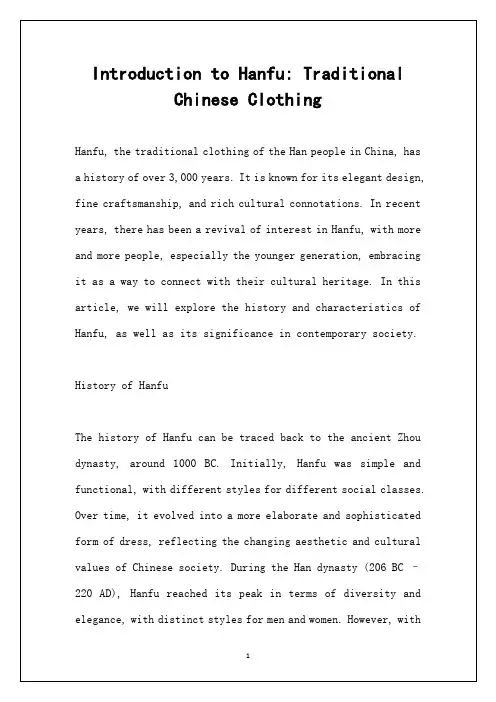

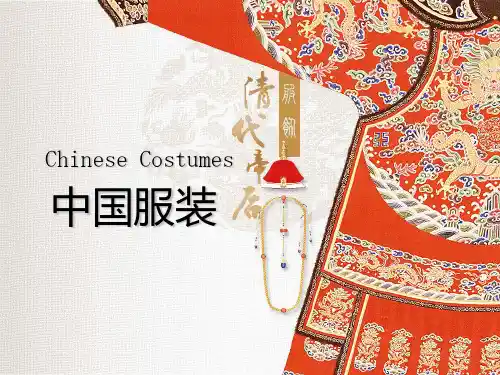
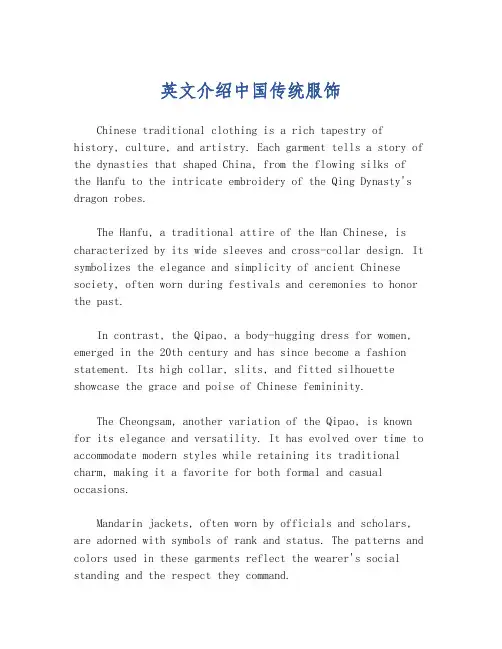
英文介绍中国传统服饰Chinese traditional clothing is a rich tapestry of history, culture, and artistry. Each garment tells a story of the dynasties that shaped China, from the flowing silks of the Hanfu to the intricate embroidery of the Qing Dynasty's dragon robes.The Hanfu, a traditional attire of the Han Chinese, is characterized by its wide sleeves and cross-collar design. It symbolizes the elegance and simplicity of ancient Chinese society, often worn during festivals and ceremonies to honor the past.In contrast, the Qipao, a body-hugging dress for women, emerged in the 20th century and has since become a fashion statement. Its high collar, slits, and fitted silhouette showcase the grace and poise of Chinese femininity.The Cheongsam, another variation of the Qipao, is known for its elegance and versatility. It has evolved over time to accommodate modern styles while retaining its traditional charm, making it a favorite for both formal and casual occasions.Mandarin jackets, often worn by officials and scholars, are adorned with symbols of rank and status. The patterns and colors used in these garments reflect the wearer's social standing and the respect they command.The Zhongshan suit, a modern adaptation of traditional attire, is named after Sun Yat-sen, the founding father of modern China. It combines elements of Western and Chinese fashion, symbolizing unity and progress.Accessories such as the Ruyi, a jade scepter, and the fan, a symbol of refinement, were integral to traditional Chinese attire. They not only served practical purposes but also conveyed social messages.In conclusion, Chinese traditional clothing is more than just garments; it's a reflection of the nation's soul, aliving testament to the rich heritage that continues toinspire and influence fashion today.。
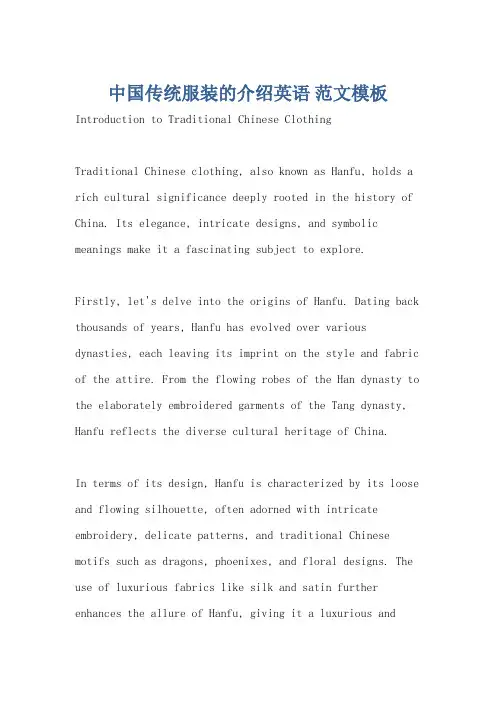
中国传统服装的介绍英语范文模板Introduction to Traditional Chinese ClothingTraditional Chinese clothing, also known as Hanfu, holds a rich cultural significance deeply rooted in the history of China. Its elegance, intricate designs, and symbolic meanings make it a fascinating subject to explore.Firstly, let's delve into the origins of Hanfu. Dating back thousands of years, Hanfu has evolved over various dynasties, each leaving its imprint on the style and fabric of the attire. From the flowing robes of the Han dynasty to the elaborately embroidered garments of the Tang dynasty, Hanfu reflects the diverse cultural heritage of China.In terms of its design, Hanfu is characterized by its loose and flowing silhouette, often adorned with intricate embroidery, delicate patterns, and traditional Chinese motifs such as dragons, phoenixes, and floral designs. The use of luxurious fabrics like silk and satin further enhances the allure of Hanfu, giving it a luxurious andregal appearance.One of the distinguishing features of Hanfu is its emphasis on modesty and propriety. Unlike Western clothing, which often prioritizes form-fitting styles, Hanfu focuses on draping and layering to create an aura of gracefulness and elegance. The concept of modesty is deeply ingrained in traditional Chinese culture, and Hanfu reflects this value through its design and aesthetics.Moreover, Hanfu serves as a visual representation ofChina's rich cultural heritage and social hierarchy. Historically, different styles of Hanfu were worn by individuals of varying social status, with colors, fabrics, and accessories serving as indicators of one's rank and position in society. For example, during the Tang dynasty, only members of the imperial family were permitted to wear yellow, the color symbolizing royalty and power.In addition to its cultural significance, Hanfu also plays a significant role in modern Chinese society. In recent years, there has been a resurgence of interest in Hanfuamong young people, fueled by a growing appreciation for traditional culture and heritage. Today, you can find enthusiasts wearing Hanfu not only during traditional festivals and ceremonies but also in everyday life, as a way to reconnect with their cultural roots and expresstheir individuality.In conclusion, Hanfu represents more than just a form of clothing; it embodies the rich history, cultural heritage, and values of China. Its timeless elegance and symbolic significance continue to captivate people around the world, serving as a testament to the enduring legacy oftraditional Chinese clothing.。
汉服分类及介绍英文作文英文:Hanfu is a traditional Chinese clothing style that has been around for thousands of years. It is a unique and beautiful fashion that has been passed down through generations. Hanfu can be categorized into different styles based on the time period and region it originated from.The first style is the "Zhongshan Zhuang" style, which originated from the Han Dynasty (206 BC-220 AD). This style is characterized by its long and flowing robes, with a high collar and wide sleeves. It is usually made of silk or other high-quality fabrics and is often decorated with intricate embroidery.The second style is the "Tang Zhuang" style, which originated from the Tang Dynasty (618-907 AD). This style is characterized by its tight-fitting and short-sleeved tops, with long skirts or pants. It is usually made of silkor cotton, and is often decorated with bright colors and patterns.The third style is the "Ming Zhuang" style, which originated from the Ming Dynasty (1368-1644 AD). This style is characterized by its loose and flowing robes, with wide sleeves and a high collar. It is usually made of silk or other high-quality fabrics, and is often decorated with intricate embroidery and patterns.The fourth style is the "Qing Zhuang" style, which originated from the Qing Dynasty (1644-1912 AD). This style is characterized by its long and flowing robes, with a wide collar and tight sleeves. It is usually made of silk or other high-quality fabrics, and is often decorated with intricate embroidery and patterns.In addition to these four main styles, there are also many regional variations of Hanfu, such as the "Hanfu of the South" and the "Hanfu of the North". Each style has its own unique features and cultural significance.中文:汉服是一种有着数千年历史的传统中国服饰风格。
汉服,即汉民族传统服饰,,正式名称为华夏衣冠,古又称汉装、华服、汉衣冠等。
汉服起源于华夏文明肇始的炎黄时代,定型于春秋战国,汉民族在汉朝正式形成后遂有汉服之名。
此后,历朝历代均有沿革,但其基本特点从未改变。
汉服大体上可分为周汉汉服、魏晋南北朝汉服、隋唐汉服、宋明汉服四个发展阶段,周汉风格古朴凝重,魏晋风格潇洒飘逸,隋唐风格雍容华贵, 宋明两朝为汉服的集大成时代, 古朴、典雅、华贵、明快等多种风格并存,百花齐放,形成了蔚为大观的汉服体系。
(满清入关后,汉服在满清政府“削发易服”的民族压迫政策下被人为禁止。
此后,代表中国文化的正统华夏衣冠——汉服,从中华大地基本消失。
)汉服的主要特点是交领右衽、隐扣束带、宽袍大袖,不用扣子,而用绳带系结,给人洒脱飘逸的印象,这些特点都明显有别于其他民族的服饰。
汉服有礼服和常服之分,礼服制式严谨,为正式场合穿的服饰;常服一般去掉大袖,适合百姓日常起居。
以衣冠(汉服)、礼仪(汉礼)为表征的中国,被邻国评为衣冠之国、礼仪之邦。
汉服运动是旨在以复兴汉民族传统服饰为媒介,引导人们增强对传统文化的关注和思考,寻回失落的华夏情节,由物质的汉服导向精神的文明,并最终实现传统中华文化向现代转型的社会文化复兴运动。
“中国有服章之美谓之华,有礼仪之大谓之夏”,与华夏衣冠(汉服)相应的礼不是形式,而是民族历史之积淀,民族之根脉,汉服之美更须礼仪之大的依托。
礼的卑己尊人、长幼有序、严密规范诠释着华夏社会的理想,而庄重、纯正、质朴的周礼更充分的发挥了礼的内涵。
汉服属广义的礼的范畴,通过礼仪的形式,指向华夏文明的内涵,因此汉服是礼与仁的统一。
Han served, that is, the traditional costume of the Han nationality, formally known as the Chinese dressed, also known as the ancient Chinese equipment, and services to China and Chinese dressed, and so on.第一张图。
深衣Deep Clothing
汉:这个衣服是来距今两千多年的汉朝,是妇女穿的,大家注意一下她的特色在于她的,衣领,袖子,腰带。
首先衣领是交叉口,袖子又称袂mei ,并且它又宽又长,体现着以袖为地,以领为天,心怀的思想。
其次腰间的又大和长的带子有装饰性还有象征性,象征权利。
Hanfu: This kind of cloth comes from Han dynasty which has more than two thousand years history and worn primarily by woman. Please have a look at her collar, sleeves and belt. First look at the collar, the main feature of it is wrapping the right side over before the left. Sleeves, we also call Mei, it is wide and long, reflecting the thinking of regarding Sleeve as ground, collar as the sky and
Harbor the earth. Second, big and a long waist strap are decorative as well as symbolic, a symbol of power.
齐胸襦裙
唐:距今一千多年,衣服在贵族、歌舞伎者流行,材料是纱制的,以丰满和胖为美,袒胸露臂,色彩艳丽。
slip skirt
Tang Dynasty: a thousand year from now, the costume which is made of yarn is popular with nobility and kabuki, chubbiness is considered as beauty, lay bare one's bosom and arms, beauifully colored
清:一百多年前,是皇帝的女儿,格格gege公主,身穿旗qi装,头带旗髻ji,饰品多为牡丹花,以满地印花、绣花等工艺手段作装饰
皇帝,龙袍色用明黄,黄色象征尊贵,皇帝本身是龙的化身,胸前图案有一统山河之意。
衣服多为手工刺绣,由200多个工匠耗时两到三个月完成。
Here comes gege,gege in Manchurian language means noble female descendant,especially Princess. She's wearing a Cheongsam, Manchurian speciality, the chignon as well. That type of Manchurian chignon usually decorated with peony,wide blotch printing as well as embroider.
Imperial's robe, that is, dragon robe, it
illustrates the emperor is the Dragon's embodiment to rule the nation,main color is deep yellow, showing its a symbol of loyalty. The printing in front of his breast means unite and rule the whole country. Most of these clothing are decorated by handcraft embroider, which made by over 200 artizans and took 2-3 months.
民国、:20世纪,新主义革命时代,是革命领导人先生结合西方衣服,创造出来,象征新时代的开始。
特色在于翻领,对其五颗纽扣,行政,立法,司法,考试,监察。
大多由学者,革命人穿。
由大家族千金小姐,结婚时穿,头戴金饰,下身裙裤,方便走动。
Min: It was created by Sun Yat-sen in the new democratic revolution of the 20th century. The leader of the revolution Mr. Sun created the clothes with the characteristic of suits. It represented the beginning of a new era. It is special for the lapel and the five buttons are symbol of administration, legislation, judicature, examination and supervision. The men`s wears were usually worn by most scholars and revolutionaries. The women`s dresses were worn by rich young ladies when they got married. In their wedding, the rich ladies decorated golden ornaments on the head and put on pantskirt in order to walk conveniently.
旗袍:保存了古代的上衣下裳的衣服特色,以绸缎、麻纱材料为主,图案:水墨花,体现女性的
气质美和身材,现用作赴宴迎宾时穿。
Cheongsam preserves the ancient type of skirt under the clothes, as the main material of the silk and hemp material.
Design: ink flower, reflecting the temperament of female beauty and body, is now used as a dinner guest to wear.。